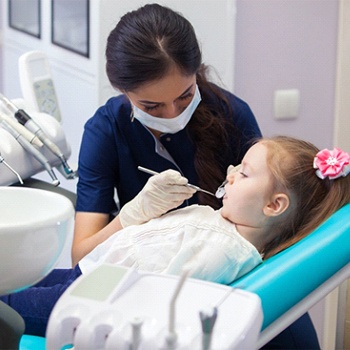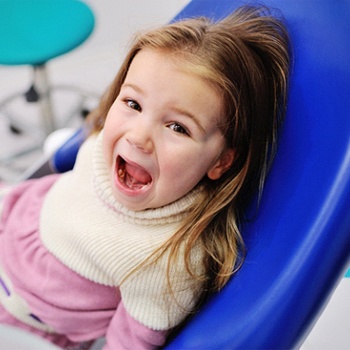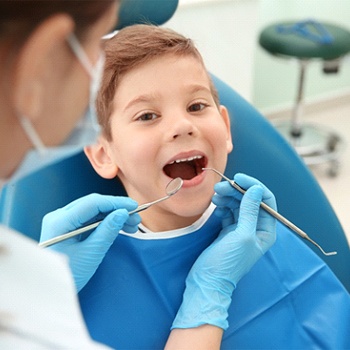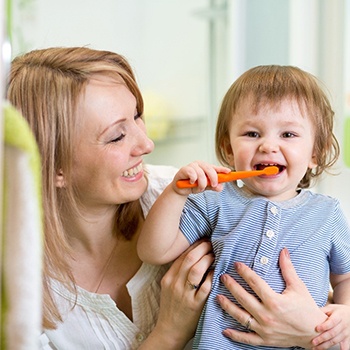
Dentistry for Toddlers – Duncanville, TX
Reliable Treatment for Growing Smiles

Are you exhausted from chasing your toddler around all day? Do you find it difficult to slow them down long enough to help them brush their teeth? It may be difficult having a sweet and innocent baby immediately turn into a rowdy and energy-filled toddler but Dr. Donna Barefield and her team are here to help! When it comes to your child’s growing smile, you can entrust us to take care of all their dental needs. From regular checkups and cleanings to tooth extractions, to helping you identify ways to break bad habits, we invite you to call our office and schedule an appointment for your little one today.
Dental Checkups and Cleanings

It is recommended that you bring your child in for regular six-month dental checkups and cleanings to prevent any problems from developing. During these visits, Dr. Barefield and her team will examine your child’s teeth, gums, and bite alignment to ensure no issues or obstacles are standing in the way of good oral health. Since your little one is still learning how to effectively brush and their teeth, we will be able to offer guidance and further explanation on how to continue these positive habits at home as well as perform a full cleaning to remove any plaque and tartar accumulations.
Dental Sealants

Typically, a child will most likely receive dental sealants between the ages of 5 and 7. If you believe your little one could benefit from this type of treatment, it is usually because they are having difficulty mastering the art of brushing and flossing, have substantial grooves in their back teeth, or are consuming lots of sugar or starches. These thin, plastic coatings are placed onto the chewing surfaces of back molars and premolars to serve as a barrier between tooth enamel and bad bacteria. With dental sealants, you and your child can worry less about food particles and plaque penetrating this barrier, but it is necessary that your child maintain good oral hygiene for them to last as long as possible.
Silver Diamine Fluoride Treatments

To better protect little smiles from cavities and tooth decay, Dr. Barefield will employ Silver Diamine Fluoride Treatments. Since fluoride is known to combat cavities, its use in combination with silver, which is a great antimicrobial agent, works to treat signs of tooth decay and stop active cavities from causing further damage to your child’s teeth. The application is easy and completely painless, as it is applied directly to the teeth without using a drill or needle.
Learn More About Fluoride Treatment
Tooth-Colored Fillings

Should your child have a cavity, we can use tooth-colored fillings to seal the tooth once it has been thoroughly cleaned by a dentist for toddlers. Using a composite resin that is matched to your child’s natural tooth color, Dr. Barefield will clean out the decayed portion of the tooth before filling it with the resin and creating an effective seal to prevent further reinfection or damage. Not only will this fill in the cavity, but it will make it nearly impossible for anyone to tell your child has had dental work.
Safe Digital X-Rays

Instead of using traditional devices that are known for large amounts of radiation, our office uses digital radiography that emits up to 90% less radiation. This not only makes it safer for your little one, but it also produces clearer, more precise images for Dr. Barefield and her team to review. Not to mention, the images captured with our machine will be displayed on a nearby monitor to allow you and your child to view.
Pulp Therapy

If your child comes to you complaining of a serious toothache, it’s likely a problem or significant infection is developing inside their tooth. The first you should take is to call our dental office. Once we have a chance to review their oral cavity and examine additional X-Rays, we can determine if the infection has reached the pulp (the innermost layer). If so, it will be necessary for us to perform pulp therapy, which is a safe and painless procedure that removes the infected pulp and cleans the tooth to avoid additional damage to the surrounding structure. It also eliminates pain and discomfort your child may be experiencing.
Non-Nutritive Habits

If your toddler is still sucking their thumb or finger, or they are continuing to use a pacifier, this could potentially spell disaster if allowed to continue. Not only can these non-nutritive habits cause teeth to grow incorrectly or a bite to become misaligned, but these problems can lead to difficulties with speech and other daily, normal functions. At Barefield Pediatric Dentistry, we can work with you to establish ways in which you can help you little one break these habits and, in turn, set them up for greater oral health in the long run.
Emergency Kid’s Dentistry

Toddlers are most definitely accident-prone. Whether it is running into a piece of furniture, falling on the concrete while playing outdoors, or jumping up and down on the bed only to fall and bite down hard on their tongue, you’re bound to be faced with a dental emergency. When this happens, make sure to call our office as soon as possible and alert us to the situation. Based on the information received, our team will determine if you should bring your child in immediately or wait and administer at-home care in the meantime. We are pleased to provide same-day appointments for all emergency patients.
Tooth Extractions

Should pulp therapy or alternative solutions prove ineffective, we will likely need to perform a tooth extraction. Baby teeth are meant to fall out on their own; however, this is not always the case, and in situations where your child has severe decay or substantial damage to a particular tooth or has a baby tooth that is preventing the adult tooth from erupting, she can easily remove the tooth with the help of available sedation dentistry methods to calm their nerves.
Toddler Dentistry FAQs

If you need a dentist for toddlers who can approach your child’s dental health with compassion and a caring demeanor, you can trust Dr. Barefield and her team to provide the level of your care you desire for your little one. While offering a breadth of available services, we know you have questions about ways in which you can maintain and even improve your child’s smile. This is why we invite you to review the following frequently asked questions as they pertain to toddler dentistry. Should you require additional assistance or wish to schedule an appointment, please contact our office.
How much toothpaste should my toddler be using?
By the time your child is between the ages of 2-5, you can use a “pea-size” amount of toothpaste. Your little one may want to try brushing their teeth themselves, but you will likely need to assist, as their efforts will not get the job done effectively. After all, they’re in the early stages of learning about the importance of good oral hygiene, so helping them with brushing will ensure their smile stays healthy and cavity-free. You will also need to instruct your child to spit out the remaining toothpaste in their mouth and not swallow it.
What is the best way to handle my toddler’s toothache?
Should your toddler begin to complain of a toothache, the best way to handle this type of situation is to first check to see if there is anything lodged between their teeth. If not, have them rinse with warm saltwater, being mindful that they do not swallow the mixture but instead, spit it out. You may also place a cold compress onto their face if it becomes swollen in any way. Following the dosage instructions on the label, you can opt to give your little one acetaminophen for pain or discomfort until you can get in to see their pediatric dentist.
What are some helpful tips to encourage brushing?
Depending on your child, they may or may not be excited about brushing their teeth. To help encourage them, a few tips you can use at home include:
- Singing a song
- Allow them to play with their toothbrush before actually beginning to clean their teeth
- Brush your teeth alongside your child to make it a family affair
- Encourage them to open their mouth wide while brushing, which might require having them make animal sounds (i.e. roar like a bear or lion)
- Practice brushing on their favorite stuffed animal or doll to show them why it’s fun to brush their teeth
- Make sure to brush in the morning and before bedtime
Why are baby teeth important?
Baby teeth are considered “placeholders” for your child’s permanent teeth. Should they lose one too early, it can negatively affect their future smile. Nearby healthy teeth will begin to shift to try and close up the vacated socket, effectively moving teeth out of alignment and causing your child to need orthodontic treatment in the future.
It’s important that you help your child keep their baby teeth as long as possible by maintaining good oral health, keeping their six-month dental checkups and cleanings, and protective their smiles from possible damage.
Why are dental X-Rays necessary?
The dental X-Rays used today are much safer than former devices. But you may still wonder if they’re actually necessary. By the time your child reaches the age of 2 or 3, these additional images can give Dr. Barefield a clearer look at what is happening beneath the gums. Examining all aspects of their smile, these X-Rays can provide a clear picture should your child be at risk for cavities.